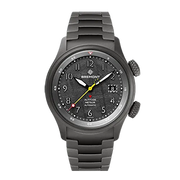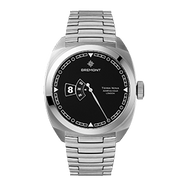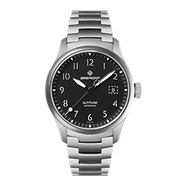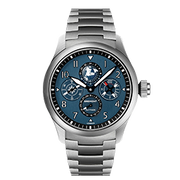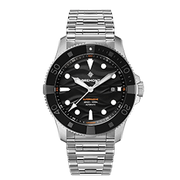After 33 years, MB1 owner Ian and his navigator still hold the record for combined lowest and fastest survivable ejection in the history of the Royal Air Force.
After visiting Bremont HQ to pick up his MB1, Ian shares his horrifying survival story...
The 29(F) Squadron programme drawn up for the week designated four Phantom FGR2 aircraft sortie for low level practice intercepts over land for Tuesday 7th January 1986 of which I was the number 3 aircraft in the formation crewed up with my navigator Flight Lieutenant S. Williams.
As I left the squadron Operations Room the night before, I was really looking forward to an exciting sortie over North Yorkshire and Wensleydale briefing at 08.00hrs for a 09.00 take-off. The sortie would last approximately 1hr 15mins.
Back home and just a short distance from RAF Coningsby, I enjoyed a busy Monday evening helping Liz to look after our two daughters Louise (7yrs) and Claire (5yrs). A routine of tea, playtime, getting the girls ready for bed then story time followed by a little prayer. After the girls were settled, Liz and I tidied up the lounge and kitchen putting toys away or washing up and then relaxing watching some television and talking about the day.
On the Tuesday morning I woke early whilst Liz was still asleep. Quietly, I crept to the bathroom without waking anyone; got ready and then had breakfast whilst going over sortie profile in my mind and all that entails about flying a 26 ton supersonic jet low level over land. The weather looked good - crisp and cold with bright sunshine as I closed the front door with the latch making a ‘click’! I drove to the 29(F) squadron complex on the far side of the airfield with its distinctive bomb proof hardened aircraft shelters (HAS) of which the squadron operations building was in the centre of the complex.
I changed into full flying kit, which for winter operations meant a heavy cumbersome immersion suit similar to a diving suit, which protected us from hypothermia if we had to eject into the sea or in my case overland. Very grateful I was to wear it just a few hours later lying in deep snow.
Underneath was my ‘G-suit’ which automatically inflated when pulling more than twice the force of gravity(2G) squeezing the legs and abdomen to maintain sufficient blood pressure to the upper body and head so avoiding grey-out or even worse ‘black-out’ and loss of consciousness!
Wearing a ‘G-suit’ became second nature for aircrew as we ‘hunted and grunted’ (rapid breathing and grunting to maintain high oxygen levels to the brain) all against the manoeuvring g-forces!
The brief went ahead as normal including call sign (usually Triplex or Horsemen) favourable weather conditions in the Pennines area for low level flying, a tactics brief, order of attacks and possible emergencies such as bird strikes. Yes, a seagull hitting your wing can make a huge dent as I experienced, but that is another story! Diversion airfields and fuel limits. Thirty minutes later we were fully kitted with life-jackets and helmets in hand walking to our respective HAS’s to ‘crew-in’ and start up the huge Rolls Royce Spey reheated engines together which produced 33,000lbs of thrust – awesome! Checking in on Ground frequency as the Formation Lead called for ‘Horsemen check-in’ followed by 2-3-4 in military precision, then Loud and clear from our leader as he then called for ‘Horsemen formation taxi’.
My Phantom FGR2 tail letter ‘J’ for Juliet and its airframe number XV434 moved forward off the chocks and out of the HAS into the winter sunshine as I powered up the 2 Speys with a short burst of thrust and waved off the ground crew with a thumbs up and then followed the lead and number 2 out of the HAS site onto the taxi way. Pre-take-off checks completed….flaps to mid. Lead called us to Tower frequency ‘Horsemen Stud 2, stud 2 GO!’ Horsemen check-in’ 2-3-4. We lined up as a 4-ship on Runway 08 and did a formation take off in pairs with 30 seconds between elements. We formed wide battle formation as we departed Coningsby in transit at 3,000ft. No time to relax as after take-off checks needed completing with a change of radio for Horsemen to check in on departure frequency.
Weapons checks completed; radar up and running - we were ready to go. Head always moving in the cockpit, left shoulder to right shoulder then reverse looking over the top. More aircraft have been shot down in war visually than any other way of detection because the doomed pilot was simply looking straight ahead (bore sighted) as we called it! Look out is essential for survival not just in war but in peace time – especially for birds or light aircraft, gliders etc.
Into the low level area prior to which we carried out more low level checks and set the RPS (regional pressure setting) on our altimeters – so we were all working to the same datum. Visibility was in excess of 20 kms. No cloud below 15,000ft.
Horsemen lead and number 2 were acting as targets flying 3 miles line astern of each other at 250ft/500ft and a speed of 450knts/400knts respectively prior to the emergency that was about to take place. Having engaged and simulated a Sidewinder shot on the stern target I continued to chase the lead aircraft for another stern missile shot and needed extra speed to close up. Initially, I engaged the reheats and at 540knts just exceeding the maximum permitted airspeed over land at 550knts!
At this moment in time the nose of my Phantom jet gently but positively dipped 10 degrees nose down towards the ground without any control input from me, known as a UCM or uncontrolled manoeuvre. I raised the nose by pulling gently back on the control column to gain height and safety. The jet violently pitched up 30 degrees so I pushed the control column 1inch forward and the jet again violently pitched down 35 degrees and alarmingly I could only see ground, rocks in the canopy racing frighteningly towards me and no sky whatsoever, so I again tried to lift the nose of the jet as it pitched to 50 degrees nose up and 8G forcing my head onto my knees. I knew in these few seconds I was going to leave!!! I pushed the control column forward and ran the electric trimmers forward so this screaming 26 tons of metal was always going into the ground! I pulled the seat pan ejection handle between my knees with just my right hand – such was the extreme urgency to get out. Whilst I still had my left hand on the pair of throttles. It takes 44lbs of force to pull the Martin Baker handle out of its seating to initiate ejection, but I can confirm with the reader it came out easily! Adrenalin rush, time expansion…my thoughts in fractions of seconds…550knt (600mph+ at 250feet) wind blast – will I survive?
Thinking bizarrely, that handle won’t go back in now – im leaving!
I need to get out now not tomorrow (yes a mille-second seemed like a minute)
Full pull of handle – I screamed to Steve Williams (Nav) ‘EJECTING’
Bang! Seat cartridge fired starting the Martin-baker ejection seat rising
Next experience was looking outside of my cockpit down the front glass of my cockpit. If I’d had a yellow duster I could have cleaned it from the outside.
THEN the rocket pack fired on the ejection seat with 3,000lbs of thrust – accelerating my body from 0-60mph in 0.3seconds!
Friend, I felt every pound of thrust as it kicked me and squashed me into the seat and lungs collapsed with enforced scream as I saw myself come out of the cockpit and the 26 tons of metal travelling at 600mph slipped underneath my feet.
I could hear the barastatic time release unit ticking and I seemed to be tilting backwards and rotating in the seat when a thought impressed on my conscience – will I live or die – will the seat work in time?
Suddenly, whoomph! Main parachute deployed, seat separated! Everything deadly quiet apart from the gentle sound of breeze and an enormous fire ball in front of me racing to the heavens surrounded by column of thick black smoke!
ALL of the above from pulling the martin Baker ejection handle to being on a fully deployed Parachute was 2.75 seconds!
Automatic drills kicked in – I raised my arms to check the parachute rigging lines were good and not tangled. Problem! Only my right arm went up! I could tell my left arm was broken close to my elbow and wrapped around it was my PEC (personal equipment connecter-R/T, O2 & G-suit) I daren’t move the PEC. I went to check my visors, oxygen mask etc – gone in the blast. My hands were bare as my flying gloves had also been ripped off. All the seals on my immersion suit burst.
I was only on the parachute for 20 seconds when I saw such a rush of ground – a speed I had truly never seen before and braced my legs together to avoid breaking them. However, in 20 seconds chute time I had not been able to lower my survival pack – a fibre-glass box filled with items such as a dingy for ejections over the sea, warm hat gloves, water, distress signalling mirror, fishing line slammed into my right leg as I impacted the ground and broke it in two places, just below the knee and just above the ankle. I bounced forward and stopped for a fraction of a second thinking I’m alive!
Then surprisingly, the parachute caught in the wind on top of Walden Pike/Buckden Pike one of the highest points in the Pennines and I was then dragged across the mountain feeling my head hitting against the rocks. I screamed out to God – ‘Save me!’ I had sufficient energy to roll over and turn my QRF (quick release fitting) and hit it with one hand to feel my parachute harness slip away underneath my body and I thought I was free….however, in the 20second descent on the parachute as you have just read, I didn’t have enough time to release my survival pack so the connecting 10mtrs of lanyard suddenly pulled out and still connected to my hip started pulling me across the mountain all over again!
The brow lining of my helmet fell out over my eyes so I was blinded until I managed to use my right hand to lift the padding away and see that in the sky was a full blown parachute, underslung harness and survival pack being lifted into the sky and about to drag me over the edge of a cliff if I couldn’t release myself. I screamed another prayer to Jesus – Save me! I then stuck my good leg into the snow and after a went up to the Martin Baker clip connecting me to the chute, harness and pack…squeezed it and realised the clip was packed with ice from being dragged across the snowy mountain top! I fell back rested for 2 seconds, went up again and the same thing happened. I was exhausted! But went up a third time and felt ice melting and a sudden ping! The whole package blew away and I fell back onto the snow and sang to God. It was a well-known Christian song…the words:
Be bold, be strong
For the Lord thy God is with thee
Be bold be strong for the Lord thy God is with you
I am not afraid
I am not dismayed
For the Lord your God is with you.
I then carried out a body check and came to the conclusion that I had a badly broken arm and two breaks in my right leg.
I prayed I wouldn’t have any pain or go unconscious.
Jesus answered my prayers – no pain as I waited for a rescue helicopter to come…
My broken arm was tangled up in my PEC and therefore I couldn’t activate my PLB (personal Locator beacon) I waited and surprisingly, what seemed such a short time to me in God (was about 1 hr) I could hear the reassuring sound of a helicopters rotor blades…such wonderful heartening noise – 22 Squadron had arrived. The winchman jumped out and ran across to me saying, ‘You look great!’ I said, ‘I am ok but have a broken arm and broken leg – besides how did you find me as I couldn’t activate my PLB. The winchman said, ‘It was going all the time’! Reader – God knows where you are and what you need – HE is in the business of rescuing our souls, but he also shows himself to us in our hour of need.
I was then strapped into a cradle and winched into the helicopter before transiting to Catterick Garrison Hospital.
I had looked for Steve’s parachute in those 20 seconds but couldn’t see him. When I was taken into the hospital outside the ‘Theatre’ Steve was also brought in, but sounded in a very bad way. My life was spared by 5 seconds and Steve must have got out with 3 seconds to go before impact! In fact, I was to learn later that Steve passed through the fireball, had his parachute burnt in half, his helmet blown off his head and boot melted in the heat of the fireball! Amazingly, he was found in the first-aid semi-conscious position on the mountain which saved his life. Not with standing, I could hear him groaning and the doctors telling me they would work on Steve first. No worries. He did stop breathing over 33 times in the next few days and his life was in a critical situation. My wife Liz asked many churches to pray for us both, but especially Steve. We were told later he would never walk again and be mentally affected after he’d broken his back and impacted his ankles and hit his head on during his escape. I can testify that against all odds we both walked back into 29 Squadron 6 months later and both went back to flying, myself on Phantoms and Steve on AWACs multi-engine jets as he had a displaced vertebrae which prohibited him using an ejection seat again!
I simply believe our prayers were answered.
The RAF AAIB(Air Accident Investigation Board) found there had been a failure in the ‘Feel-Bellows’ pitch control system that meant this emergency was not recoverable by the pilot and the jet was going to crash regardless.
I am so grateful to Martin-Baker, their fantastic ejection seat Mk7A – It works! And now saving thousands of lives around the world. I thank God for engineers, technicians and people with the most amazing design skills, inventiveness is just awesome!
However, I don’t think you would want to beat our record, which still stands after 33 years, of being the combined lowest and fastest survivable ejection in the history of the Royal Air Force (600mph-250feet).









